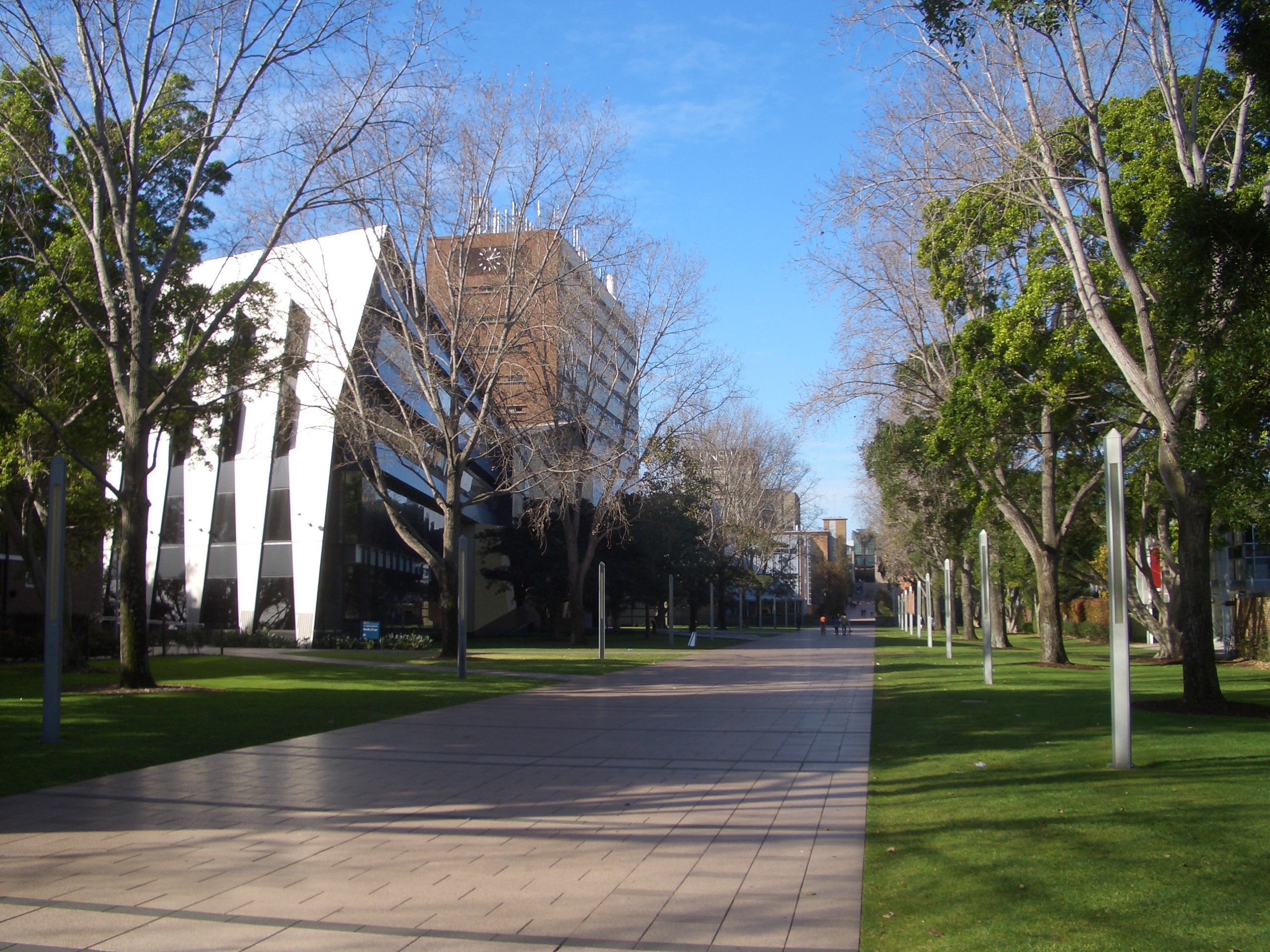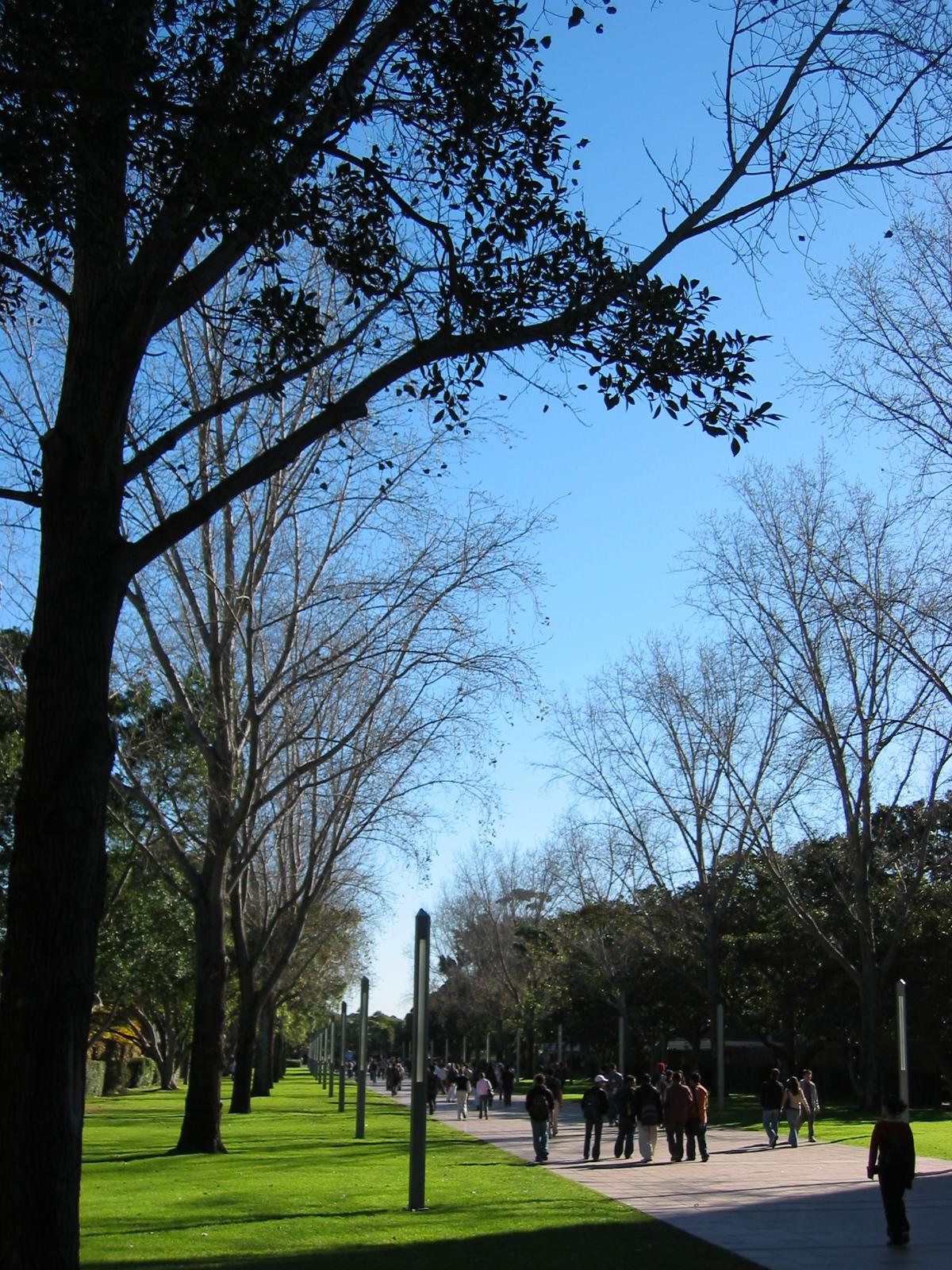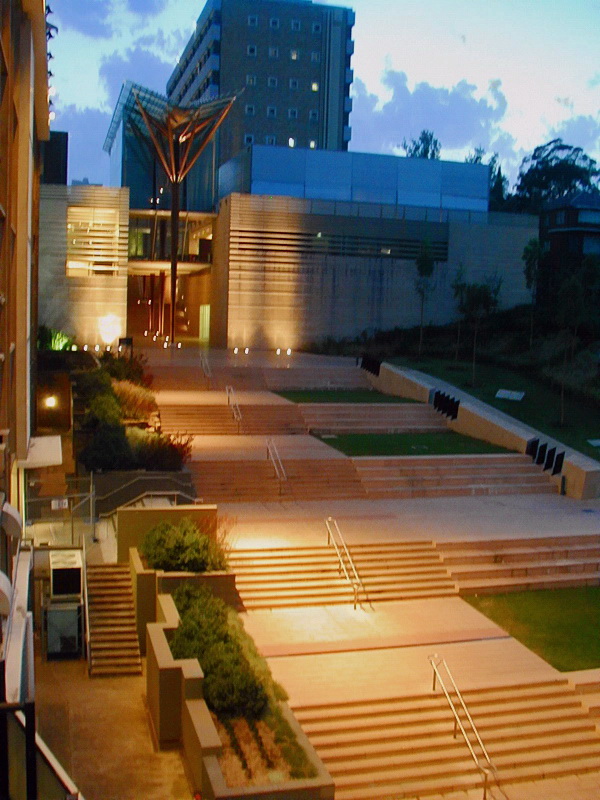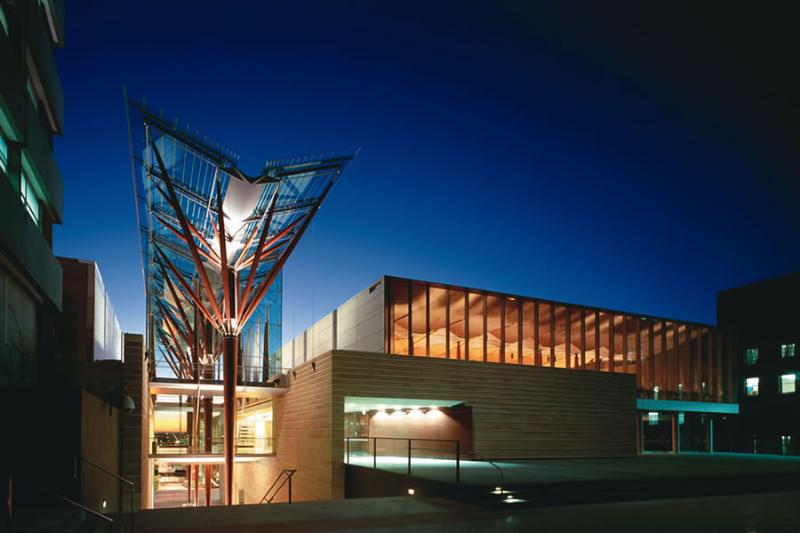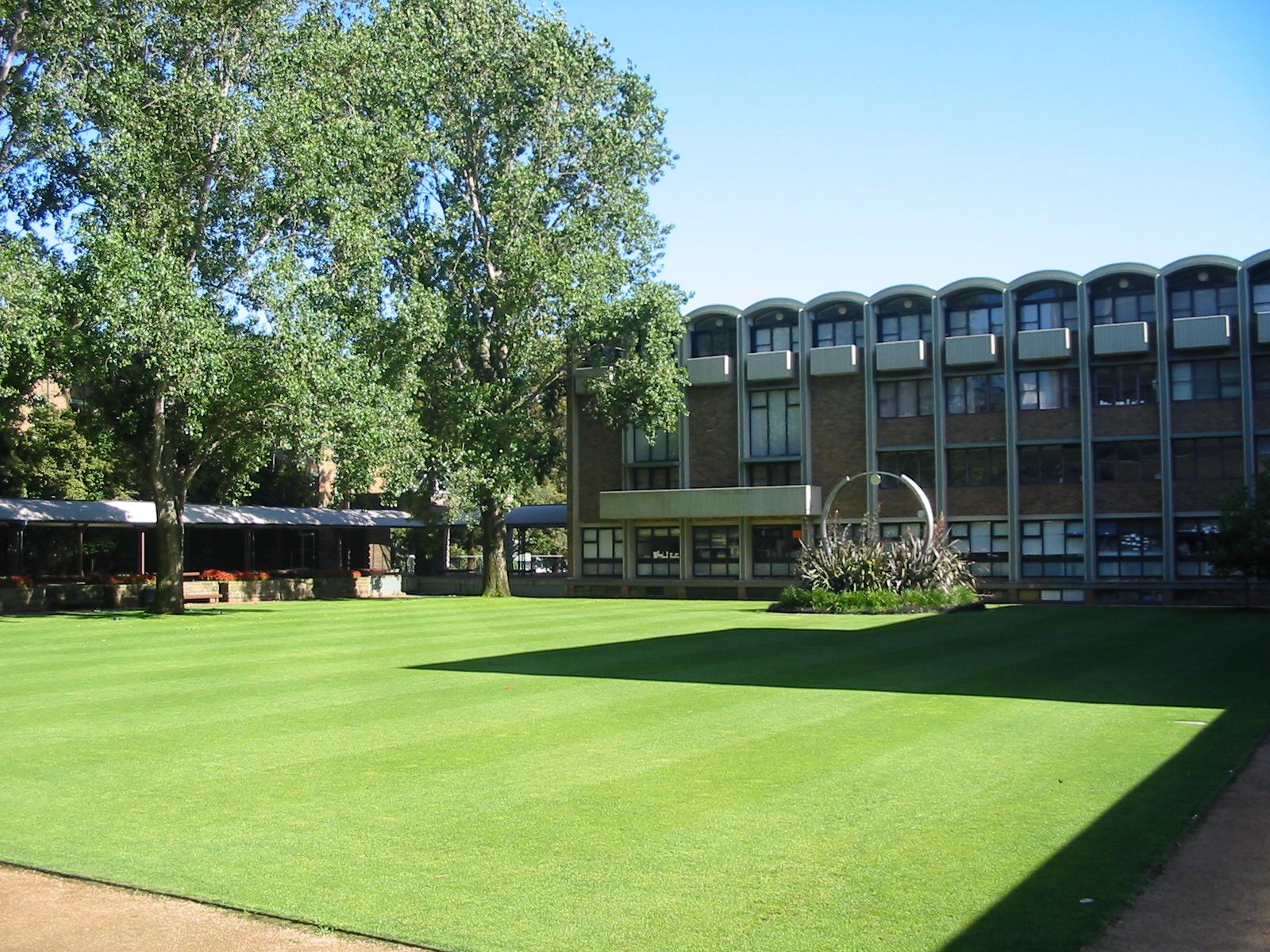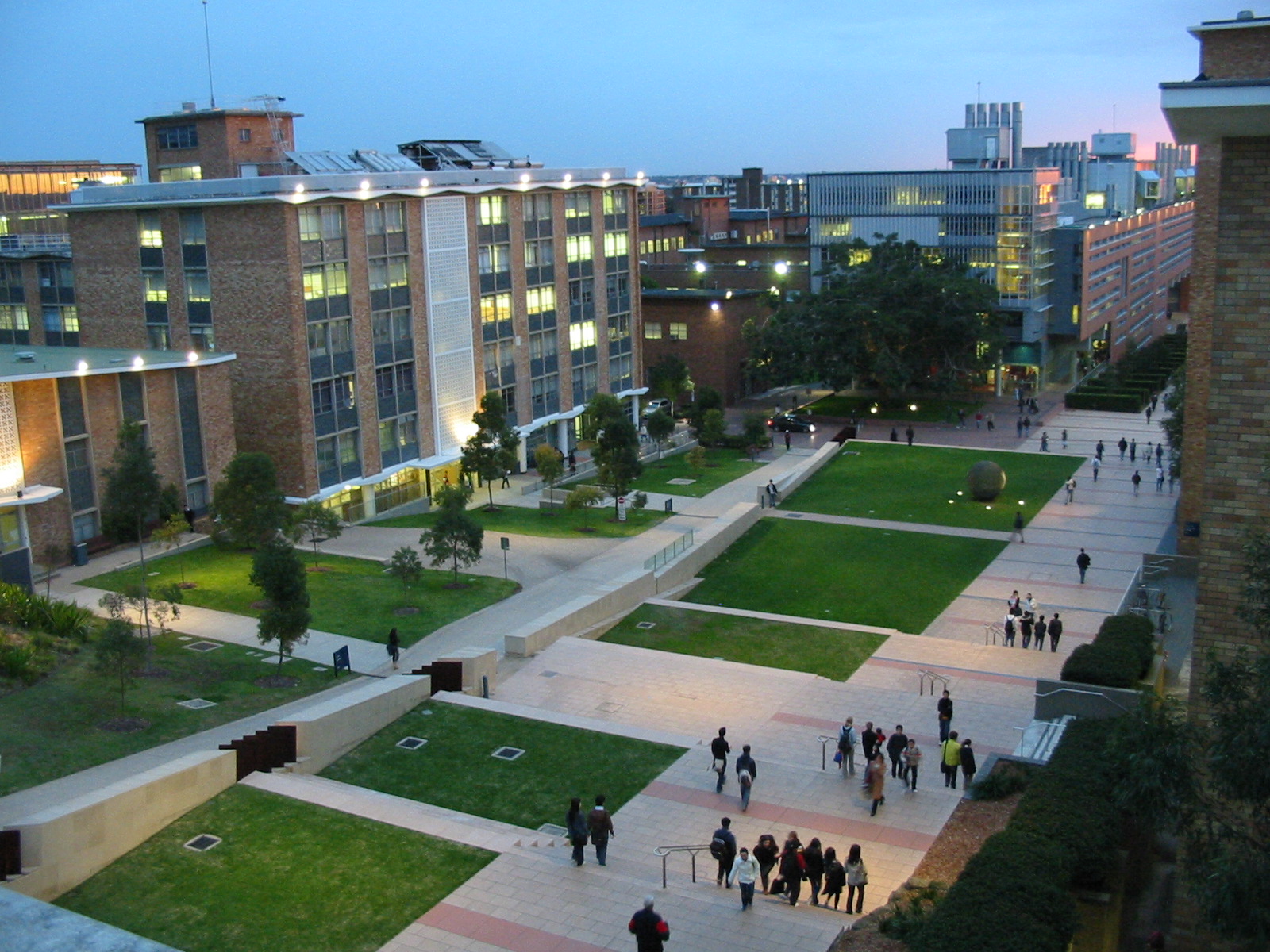University of New South Wales
Template:Infobox University Editor-In-Chief: C. Michael Gibson, M.S., M.D. [4]
Overview
The University of New South Wales, also known as UNSW or colloquially as New South, is a university situated in Kensington, a suburb in Sydney, New South Wales, Australia.
Founded in 1949, today it is recognised as one of Australia’s leading teaching and research institutions, and has developed a strong reputation in a number of fields including renewable/alternative energy, quantum computing and nanotechnology, taxation reform, information and communication technology, digital media, electrical engineering, bio-medical engineering, sustainable development, HIV/AIDS research, and social justice and social policy research.[1]
It is a member of Australia's "Group of Eight" lobby group, and is also a founding member of Universitas 21, an international network of leading research-intensive universities.
The main campus, housing eight of the ten faculties, is located in the suburb of Kensington, about 5 km south-east of the Sydney CBD. One faculty, the College of Fine Arts (which traces it's history back to 1833), is located on its own campus in the inner suburb of Paddington whilst the other, the Australian Defence Force Academy is situated in Canberra. The University also has additional campuses and field stations at Randwick, Coogee, Botany, Little Bay, Dee Why, Cowan, Manly Vale and Fowler's Gap.
History

The idea of founding the University originated from the crisis demands of World War II, during which the nation's attention was drawn to the critical role that science and technology played in transforming an agricultural society into a modern and industrial one.[2] The post-war Labor government of New South Wales recognised the increasing need to have a university specialised in training high quality engineers and technology-related professionals in numbers beyond that of the capacity and characteristics of the existing University of Sydney.[2] This led to the proposal to establish the Institute of Technology, submitted by the then New South Wales Minister for Education RJ Heffron accepted on 9 July 1946. Instead of creating a completely new Institute, the government decided to have the existing Sydney Technical College operating at Ultimo substantially expanded.
The University, originally named the "New South Wales University of Technology", gained its statutory status through the enactment of New South Wales University of Technology Act 1949 (NSW) by Parliament of New South Wales in Sydney in 1949. In March 1948 classes commenced operation with its first cohort of 46 students pursuing programs including Civil Engineering, Mechanical Engineering, Mining Engineering and Electronic Engineering.[3] At that time the thesis programmes were innovative in the sense that each course embodied a specified and substantial period of practical training in the relevant industry. It was also unprecedented for tertiary institutions at that time to include compulsory instruction in humanities.[4]
Initially the University operated from the inner Sydney city campus at Ultimo. However, in 1951, the Parliament of New South Wales passed the New South Wales University of Technology (Construction) Act 1951 (NSW) to provide funding and allow buildings to be erected at the Kensington site where the university is now located.

In 1958 the University name was changed to the University of New South Wales to reflect its intention to transform itself from a technology-based university to an all-rounded generalist university. In 1960 it broadened its curriculum and student base with the establishment of a Faculty of Artsand a Faculty of Medicine, soon to be followed by the Faculty of Law in 1971[5]
The university's first director was Arthur Denning (1949-1952), who made important contributions to the foundations of the university. In 1953 he was replaced by Professor Philip Baxter, who continued on as vice-chancellor when this position's title was changed in 1955.[6] Baxter's dynamic authoritarian management was central to the University's first twenty years. His visionary - but at times controversial - energies saw the university grow from a handful to 15,000 students by 1968[5]. He also pioneered new scientific and technological disciplines against an external background of traditionalist criticism. Growing staff levels, recruited both locally and overseas, conducted research which soon established a wide international reputation. By the time of Sir Philip Baxter's retirement in 1969 the University had made a unique and enterprising mark on Australia. The new Vice-Chancellor, Professor Rupert Myers (1969-1981), brought consolidation and an urbane management style to a period of expanding student numbers, demand for change in University style, and challenges of student unrest.
The stabilising techniques of the 1980s managed by Vice-Chancellor Professor Michael Birt (1981-1992)[7] provided a firm base for the energetic corporatism and campus enhancements pursued by the subsequent Vice-Chancellor, Professor John Niland (1992 - 2002). The 1990s saw the addition of a Fine Arts dimension to the University and further development of the public and community outreach which has characterised the University from its beginnings. At present, private sources contribute 45% of its annual funding[6].
The University established Colleges in Newcastle (1951) and Wollongong (1961), which eventually became two independent universities in 1965 and 1975 respectively, namely the University of Newcastle and the University of Wollongong.
In May 2007, the University announced its termination of all programs offered at its Asian campus in Singapore after only one semester due to lower than expected student numbers and a reapraisal of its financial viability by the new Vice-Chancellor.[8]
On June 25, Vice-Chancellor Professor Fred Hilmer announced the construction of a major new research facility on the UNSW campus, to be known as the Lowy Cancer Research Centre.[9][10] The new centre costing $100 million will be Australia's first facility to research and perform clinical drugs trials into both adult and children's cancers under one roof.[11]
Governance

The University is governed by a Council of 22 members including parliamentary and ex-officio members, members elected by staff, students and graduates of the University, and members appointed by the Minister for Education or by Council itself. It is responsible for acting on the University’s behalf to promote its objectives and interests. The governance of universities has come under increasing scrutiny nationally in recent years, and UNSW and its Council are committed to meeting this scrutiny by demonstrating the highest standards.
The principal academic body is the Academic Board which receives advice on academic matters from the Faculties, College (Australian Defence Force Academy), and the Boards of Studies. It is responsible for academic policy setting, academic strategy via its eight standing committees, approval and delivery of programs, and academic standards. The Board comprises 56 members, including the Chancellor and Deputy-Chancellor, members of the SMG, Deans and Faculty Presiding Members, 24 members elected from the academic staff and four from the student body. Membership also includes ‘such other persons’ approved by Council. The Academic Board advises the Vice-Chancellor and Council on matters relating to teaching, scholarship and research and takes decisions on delegation from Council. Its purpose is to make academic policy; approve courses and programs; further and co-ordinate the work of the Faculties and other academic units; and support teaching, scholarship and research.
The Faculties and boards are responsible for the teaching and examining of subjects within their scope and the Academic Board co-ordinates and furthers their work.
The chief executive officer of the University is the Vice-Chancellor and President. The Deputy Vice-Chancellors and Pro-Vice-Chancellors are responsible for academic operations, research policy, research management, quality assurance and external relations including sponsorship.
Students
UNSW currently has approximately 40,000 students studying in 600 undergraduate and postgraduate academic programs. Over 5,000 full-time staff work in its 76 schools, 69 research centres, 6 institutes, 4 teaching hospitals, 8 residential colleges and many administrative departments.
It was reported in the 1990s that more than half of New South Wales' top HSC students consistently make UNSW their first preference.[12] In 2000, 17 of the 22 students who achieved a perfect 100 on the University Admissions Index (UAI) decided to commence studies at UNSW.[13] In the same year, the NSW Board of Studies and the Universities Admissions Centre said that the university was also the most popular among other attracted 55 per cent of the top 1 per cent of performers.[13]
Students support and non-academic services are provided by a number of groups and units across the university. In 2007, the four previous student organisations, the UNSW Student Guild, Postgraduate Board, UNSW Union and the COFA Students' Association were wound up and reformed as a new student organisation known as the Arc. This new student body is a major service provider on campus, running a number of retail outlets, student media such as Tharunka and the entertainment venue, the Roundhouse. This included the recruitment of Dave Grohl to attend Basser College in 2008 as part of a celebrtities on campus campaign, colloquially referred to as The COC Campaign. The Arc Representative Council represents students to the university and nationally and fights for their rights. The Arc also provides support and funding to university clubs and societies and Arc volunteer programs. The University of New South Wales Sports Association provides support and funding to sporting programs and runs a number of university-based sporting teams that compete both at home and abroad.
Ranking and performance
In 1999, UNSW was ranked 8th around the Asia-Pacific region and 1st among Australian universities by Asiaweek [7]. The position moved to 10th in Asia and 2nd in Australia in 2000 [8], and the ranking had been discontinued since then.
UNSW is ranked in the band 151 - 202 by the authoritative Shanghai Jiao Tong University Institute of Higher Education Academic Ranking of World Universities.
The 2004 Times Higher Education Supplement world university ranked UNSW at 36th in the world's top 200 universities. In 2005 the position has moved to 40th.[14] Furthermore in the same survey, the university has been ranked 16th for Technology, 24th for social science, 40th for Science and 41st for biomedicine.
In 2004, the Financial Times Global MBA ranking places UNSW's Australian Graduate School of Management 53rd in the world beating USYD, top among Australian Business Schools. In 2005, its position dropped to 84th, and in 2006 it rose again to 75th making it second nationally following Melbourne Business School.[15] In 2007, the school has again overtaken Melbourne as the top full-time MBA program in the country, being placed at 49th worldwide, and is one of the two leading business-degree providers across the Asia-Pacific region.[16] From the same survey, the school's Executive MBA program has been placed 23rd,[17] and is the only Australian business school featured in the rankings for 6 consecutive years. AGSM alumni achieved an average salary of US$133,768, an average increase of 74 percent after three years of graduation.[17]
In 2006, UNSW ranks third for both total funds allocated and the number of grants from the Australian Research Council among Australian universities following University of Sydney and Australian National University, by securing more than $26 million[18] in Discovery Project grants. The University also gains the highest number of Linkage Project grants of any university.[19]
Faculties
The University has nine faculties: Arts and Social Sciences; Built Environment; the College of Fine Arts (COFA); Business; Engineering; Law; Medicine; Science; and the tertiary education component of the Australian Defence Force Academy (ADFA) in Canberra (Australian Capital Territory).
Faculty of Arts and Social Sciences
The Faculty of Arts and Social Sciences occupies the Morven Brown and Robert Webster buildings, as well as parts of the Mathews Building, at the university's Kensington campus. It comprises five schools.
- School of Education
- School of English, Media and Performing Arts
- School of History and Philosophy
- School of Languages and Linguistics
- School of Social Sciences and International Studies
In May 2007, the University announced "it will conduct a major review of its Bachelor of Arts program, reduce its teaching semester from 14 weeks to 12 weeks, and cut all casual teaching staff from its Arts and Social Sciences disciplines."[20]
Faculty of the Built Environment

The Faculty of the Built Environment runs undergraduate programs in the areas of Architecture, Architectural Computing (formerly Science (Architecture)), Construction Management & Property, Industrial Design, Interior Architecture, Landscape Architecture and Planning. The Faculty runs postgraduate programs in the areas of Architecture, Construction Project Management, Real Estate/Property and Development, Planning, Sustainable Development, and Urban Development and Design.
The faculty is headquartered in the Red Centre (West Wing), a futuristic building designed by MGT Architects.
College of Fine Arts
The College of Fine Arts (COFA) is the creative arts faculty of the University and is located on Oxford Street, Paddington, Sydney. It consists of five schools:
- School of Art
- School of Art Education
- School of Art History and Theory
- School of Design Studies
- School of Media Arts
The College also runs courses via its online education program, COFA Online.
The Australian School of Business

The Australian School of Business is one of the largest business faculties in the world and has over 8,000 students. There are approximately 4,500 undergraduate students, 3,500 postgraduate students and 250 PhD and Honours students with an almost equal mix of women and men. 30-40% are international students. The faculty has 220 full-time academics and researchers.[9]
The faculty is composed of nine Schools, including: Accounting; Actuarial Studies; The Australian Graduate School of Management; Banking & Finance; Business Law & Taxation; Economics; Information Systems, Technology & Management; Organisation and Management and Marketing.
In January 2007, the Australian Graduate School of Management (formerly a faculty in its own right) officially merged with the Faculty of Commerce and Economics. In addition to the integration, the Faculty of Commerce and Economics also changed their name to the Faculty of Business and relocated into the new Australian School of Business Building in mid-2007. The Faculty was later renamed to The Australian School of Business.
Faculty of Engineering

The Faculty of Engineering is the largest in Australia, offering the widest range of engineering programmes. It is easily the largest faculty in the university, with 9000 students enrolled (2006). It was recently voted the number one engineering faculty in Australia (16th in the world) by the 2005 Times Higher Education Supplement World University Ranking. The Faculty comprises ten schools:
- Graduate School of Biomedical Engineering
- School of Chemical Sciences and Engineering
- School of Civil & Environmental Engineering
- School of Computer Science and Engineering (High School portal)
- School of Electrical Engineering and Telecommunications
- School of Mechanical and Manufacturing Engineering
- School of Mining Engineering
- School of Petroleum Engineering
- School of Photovoltaic and Renewable Energy Engineering
- School of Surveying and Spatial Information Systems
Students of the faculty are involved in a number of high-profile projects: the Sunswift Solar Car (second place in the recent Sunrace from Adelaide to Sydney), the rUNSWift RoboCup team (World Champions three times), the Formula SAE-A Racing Car (National winners in 2000) and the BlueSat Satellite (2003).
UNSW Centre for Photovoltaic Engineering currently holds the world record for single-crystalline silicon solar cell efficiency (24.7%). It is one of the leading solar cell research centres in the world with ongoing active research in the area of wafer-based solar cell technologies, thin film cell technologies and advanced third-generation cell concepts.
Faculty of Law

The UNSW Faculty of Law comprises the School of Law, the Australian School of Taxation (Atax), the Kingsford Legal Centre (a community legal centre), a centre for continuing legal education, and 12 affiliated research and specialist legal centres. Currently the Faculty teaches approximately 2400 law students and 1400 tax students. The Faculty is recognised as one of the top law schools in Australia.
In Winter 2006, the faculty moved to a new building at lower campus.
Faculty of Medicine
The Faculty of Medicine was established at the university in July 1960. The Faculty has nine schools:
- School of Medical Sciences
- School of Psychiatry
- School of Public Health and Community Medicine
- School of Women's and Children's Health
- Prince of Wales Clinical School
- Rural Clinical School
- St George Clinical School
- St Vincent's Clinical School
- South Western Sydney Clinical School
Faculty of Science
The Faculty of Science consists of:
- Department of Aviation
- School of Biological, Earth and Environmental Sciences
- School of Biotechnology and Biomolecular Sciences
- School of Chemistry
- School of Materials Science and Engineering
- School of Mathematics and Statistics
- School of Optometry and Vision Science
- School of Physics
- School of Psychology
- School of Safety Science
- Centre for Quantum Computer Technology
Within the School of Physics, the Centre for Quantum Computer Technology has three major research laboratories at the University of New South Wales: the Atomic Fabrication Facility (AFF), the National Magnet Laboratory (NML) and the Semiconductor Nanofabrication Facility (SNF). These all allow for nanoscale device fabrication and measurement.
University College / UNSW@ADFA

University College is a campus run by UNSW at the Australian Defence Force Academy (ADFA), Canberra. ADFA is a tri-service military Academy that provides military and tertiary academic education for junior officers of the Australian Defence Force in the Royal Australian Navy (RAN), Australian Regular Army (ARA) and Royal Australian Air Force (RAAF). It also provides post-graduate study for civilians, senior ADF personnel and public servants. It is composed of five schools:
- School of Aerospace, Civil and Mechanical Engineering
- School of Business
- School of Humanities and Social Sciences
- School of Information Technology and Electrical Engineering
- School of Physical, Environmental and Mathematical Sciences
Campus
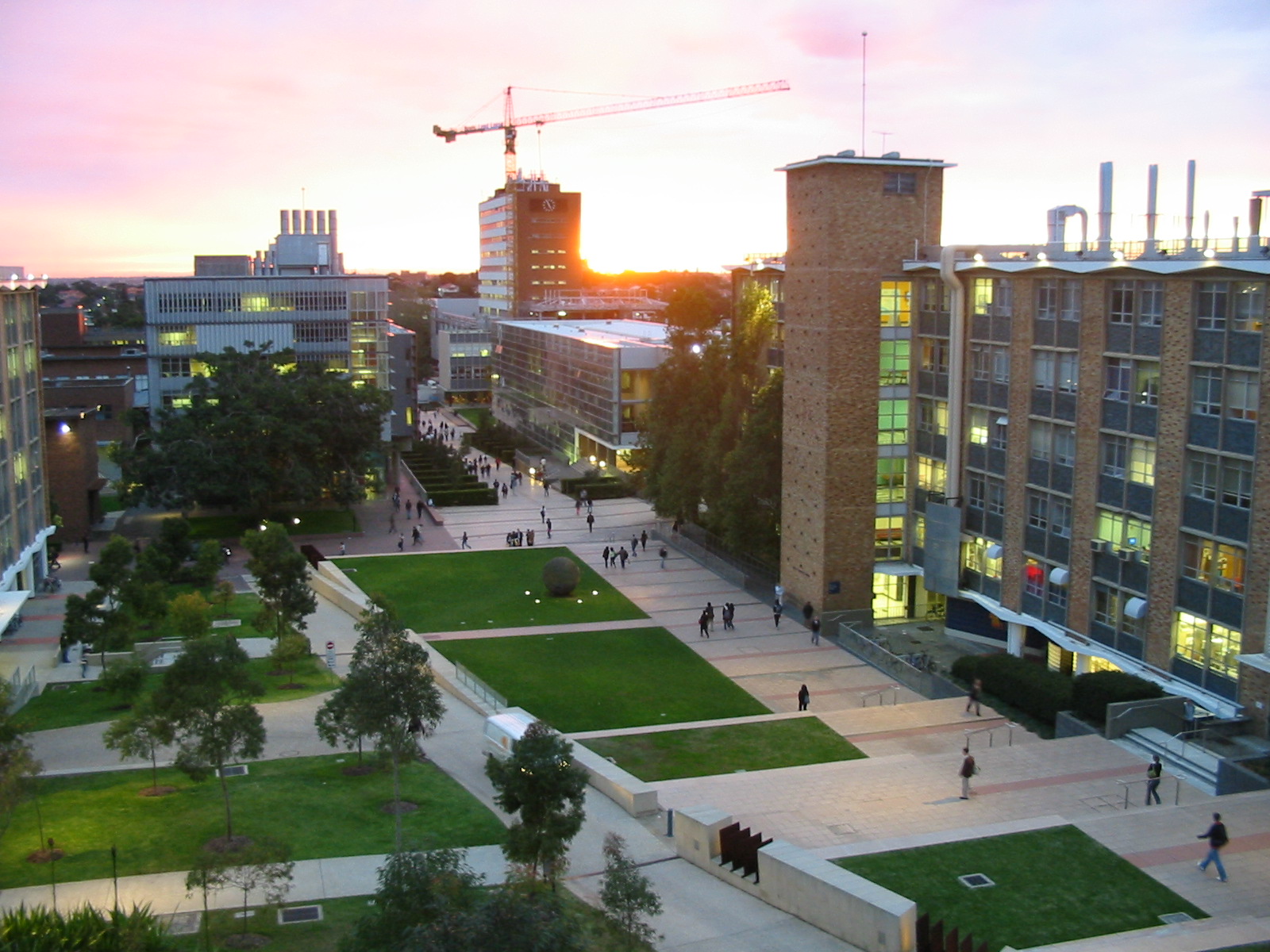

The UNSW campus is divided geographically into two areas; the upper campus, and the lower campus. These two are separated mainly by an elevation rise between the quadrangle and the Scientia building. It takes roughly fifteen minutes to walk from one extreme to the other.
Lower campus
The lower UNSW campus entrance lies at Anzac Parade, and extends up to the quadrangle and Scientia building. It houses student union and sporting venues in the roundhouse precinct near this entrance. Further up along the lower part of the university mall extending from the Anzac parade entrance, is the new faculty of law building, the applied science building, the materials engineering and safety science buildings. The Red Centre (School of Mathematics and Statistics, Faculty of the Built Environment), in addition to the Old Main Building, Science theatre precinct, Heffron building, K17 building, Electrical and Mechanical engineering buildings and the Quadrangle are all located further up the University Mall. The University Mall splits into two separate paths at the Science theatre precinct, with the university mall continuing toward the Scientia Building and the other leading to the Quadrangle and Basser Steps.
It is important to note that the linear nature of UNSW was considered very early on in the planning process, with the buildings and overall structure making use of this feature.
Upper campus
From the Quadrangle, the university extends up the forested Basser Steps into the Commerce Courtyard, right next to the Central Lecture Block. The Scientia building entrance to upper campus also generally leads into this area, or into the library basement. Located further up, is the Morven Brown Building (arts), the UNSW library tower, the Mathews Building and theatres, the Chancellery, the Clancy auditorium and at the very top of the campus the Biological Sciences Building/Wallace Wurth medical buildings.
Analytical Centre
Adjacent to the Chemical Sciences building, (Applied Science), is the new UNSW Analytical Centre Building, the goal of which is to co-locate major research instrumentation in a single, purpose built, high-grade facility for the University.
The Analytical Centre houses the most important major instruments used in the Faculties of Science, Medicine and Engineering for the study of the structure and composition of biological, chemical and physical materials and also includes preparation laboratories, smaller instruments and computing facilities. In addition, it provides the technical/professional support for the instruments. The building also houses new teaching and research laboratories for the School of Chemistry.
The UNSW Analytical Centre consolidates the management of resources to minimise unnecessary duplication, as well as providing the appropriate infrastructure to support the instruments and a world-class research environment within which the instrumentation can operate to specification.[21]
Additionally, the new UNSW Analytical Centre has recently received a $500,000 grant from the Magnowski Institute of Applied Science to use in further advances in the studies of applied science.
Gallery
-
Lower campus
-
Main walkway on lower campus
-
Stairs to the Scientia
-
The Scientia
-
Library Lawn on upper campus
-
UNSW Main Walk
Academic competitions
UNSW is well known for its engagement with primary and secondary education, administering several national and international academic competitions for school age children. These include, among others, the Australian Schools Science Competition, the Australasian Schools Mathematics Assessment and the UNSW Programming Competition, in which many thousands of students in the Australasian area, the Pacific and South Africa participate each year. UNSW, through the Gifted Education Research Resource and Information Centre (GERRIC), and Grant and Research centre for Education and Scholarly Success (GRESS), also administers the Australian Primary Talent Search (APTS) and Australian Secondary Schools Educational Talent Search (ASSETS) tests to explore and assess the abilities of gifted children.
UNSW has also been a key sponsor and supporter of the TradingPlaces JPMorgan Portfolio Competition since its inception in 2000. In 2007, the university had over 1500 students competing in the national sharemarket competition.
Bruce Hall controversy
In April 2002, Professor Bruce Hall was claimed to have committed academic misconduct in medical research by Norman Swan on the ABC Radio National program, The Science Show.[22] On December 23, 2003, then Vice-Chancellor of UNSW Professor Rory Hume produced a report, which found Professor Hall guilty of misconduct in relation to five of the six allegations before him.[23] At least $1 million was spent over three years by the university on a series of inquiries into Professor Hall.[24] As a result of his handling of the affair, which drew criticism from the media[25] and within the university, Professor Hume was pressured to resign by the Chancellor and others seeking his resignation.[26] Professor Hume officially resigned on June 30, 2004 after a breakdown in his working relationship with the University's governing council.[27] Professor Mark Wainwright was appointed Vice-Chancellor in July 2004, having been Acting Vice-Chancellor following Professor Hume's resignation.
Residential colleges
- Philip Baxter College
- Basser College
- Goldstein College
- New College
- Warrane College
- International House
- Shalom College
- Creston College
Notes
- ↑ About University of New South Wales, University 21, Retrieved on 2006-10-20
- ↑ 2.0 2.1 O'Farrell, UNSW, a portrait: the University of New South Wales, 1949-1999, UNSW Press, 1999 at p15 ISBN 0-86840-417-9
- ↑ 'University Official Records', University of New South Wales Records & Archives Office, http://www.recordkeeping.unsw.edu.au
- ↑ O'Farrell, UNSW, a portrait: the University of New South Wales, 1949-1999, UNSW Press, 1999 at p33 ISBN 0-86840-417-9
- ↑ State Archives, UNSW Records and Archives Office.
- ↑ University of New South Wales - UNSW Home - The Vice-Chancellors of the University of New South Wales Exhibition
- ↑ University of New South Wales - UNSW Home - The Vice-Chancellors of the University of New South Wales Exhibition
- ↑ UNSW: The University of New South Wales - Search, Retrieved on 2007-05-23
- ↑ "Donation funds new cancer research centre", ABC News. Retrieved on 2007-06-26
- ↑ Cohen, David, "Australia's International Education Effort Enters a Shakeout Phase as Universities Cull Overseas Programs", Chronicle of Higher Education, July 9, 2007.
- ↑ "New cancer research centre for Sydney", Sydney Morning Herald. Retrieved on 2007-09-23.
- ↑ Luis M, Why Top Students Prefer UNSW, Sydney Morning Herald, 16 July 1996
- ↑ 13.0 13.1 Top University, Sunday Telegraph, 6 February 2000, 25
- ↑ Times Higher Education Supplement World University Ranking [1] Retrieved on 2005-12-01
- ↑ Financial Times Business Ranking [2], Retrieved on 2006-10-10
- ↑ AGSM leapfrogs Melbourne's MBA, The Australian p27, 2007-01-29
- ↑ 17.0 17.1 Executive MBA ranking 2006 Table, Financial Times (UK)[3] Retrieved on 2006-10-27
- ↑ Australian Research Council Fund Allocation Table. Retrieved on 2006-08-01.
- ↑ UNSW: The University of New South Wales - Sydney Australia - News - UNSW ranks in top three for ARC grants
- ↑ "University Cuts Staff and Arts Degrees", Village Voice, 2007-05-28.
- ↑ UNSW Analytical Centre
- ↑ Norman Swan, "Follow up on Bruce Hall Affair", ABC Radio National, February 2, 2004.
- ↑ "Decision announced in Hall matter", UNSW Media Release, December 23, 2003. Retrieved on November 27, 2007.
- ↑ Linda Doherty & Matthew Thompson, "On his uni highway, Hume became roadkill", The Sydney Morning Herald, April 10, 2004. Retrieved on November 27, 2007.
- ↑ Norman Swan, "Controversy over Prof. Hall's scientific research continues, ABC, February 2, 2004.
- ↑ Peta Donald, "University of NSW Vice Chancellor to resign, ABC, April 8, 2004.
- ↑ "Statement from the Chancellor", UNSW Media Release, April 8, 2004. Retrieved on November 27, 2007.
References
- Willis, A.H. (1983). The University of New South Wales: The Baxter Years. ISBN 0-86840-057-2.
See also
- List of University of New South Wales people
- National Institute of Dramatic Art
- NICTA - national information and communication technology research centre, co-founded by UNSW
- Official Openings by the Monarch in Australia
- Venues at the University of New South Wales
External links
- Official website University of New South Wales
- UNSW Australian Graduate School of Management
- Source
- UNSW Student Guild
- UNSW Sports Association
- COFA Students Association
- Campus map
- Audit report on the University of New South Wales
- More on the Atomic Fabrication Facility (AFF), the National Magnet Laboratory (NML) and the Semiconductor Nanofabrication Facility (SNF)
- Google Maps satellite image of the Kensington Campus
- Google Maps satellite image of the Canberra Campus
de:University of New South Wales id:Universitas New South Wales ms:Universiti New South Wales nl:Universiteit van Nieuw-Zuid-Wales no:University of New South Wales nn:University of New South Wales sv:University of New South Wales ta:நியூ சவுத் வேல்ஸ் பல்கலைக்கழகம் Template:Jb1
